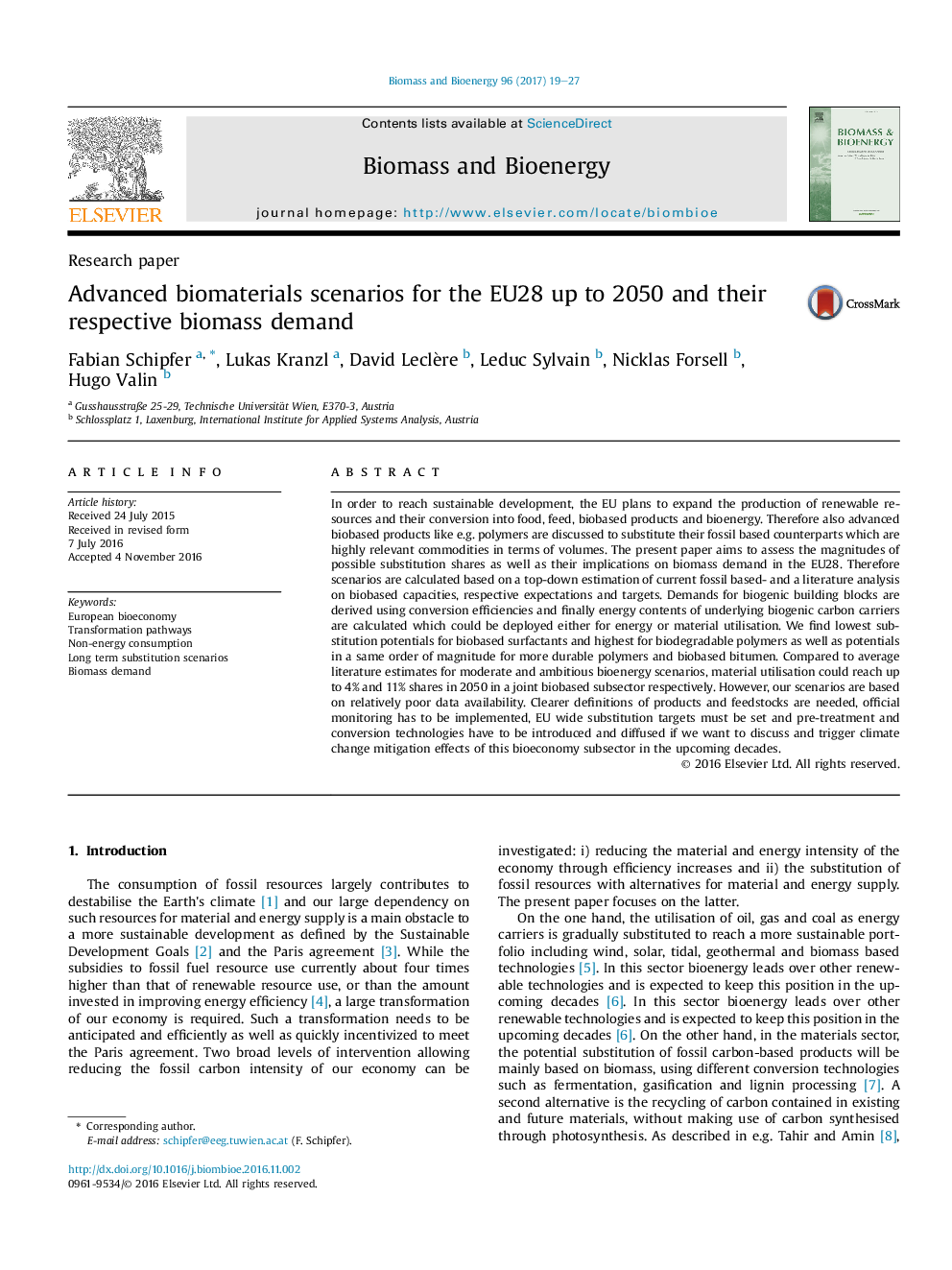| کد مقاله | کد نشریه | سال انتشار | مقاله انگلیسی | نسخه تمام متن |
|---|---|---|---|---|
| 4996399 | 1459797 | 2017 | 9 صفحه PDF | دانلود رایگان |
عنوان انگلیسی مقاله ISI
Advanced biomaterials scenarios for the EU28 up to 2050 and their respective biomass demand
ترجمه فارسی عنوان
سناریوهای زیست محیطی پیشرفته برای اتحادیه اروپا تا سال 2050 و تقاضای زیست توده مربوطه
دانلود مقاله + سفارش ترجمه
دانلود مقاله ISI انگلیسی
رایگان برای ایرانیان
کلمات کلیدی
اقتصاد زیستی اروپا مسیرهای تبدیل، مصرف غیر انرژی، سناریوهای جایگزینی بلند مدت، تقاضای زیست توده،
ترجمه چکیده
اتحادیه اروپا برای رسیدن به توسعه پایدار، قصد دارد تولید منابع تجدیدپذیر و تبدیل آنها به مواد غذایی، خوراک، محصولات زیستی و بیو انرژی را گسترش دهد. به همین دلیل نیز محصولات پیشرفته زیستی مانند مانند پلیمرها مورد بحث قرار می گیرند تا جایگزین همتایان مبتنی بر فسیل خود شوند که از لحاظ حجم به شدت مربوط به کالاها است. مقاله حاضر با هدف ارزیابی میزان سهام احتمالی جایگزین و همچنین پیامدهای آن در تقاضای زیست توده در اتحادیه اروپا 28 است. بنابراین سناریوها براساس برآورد بالای پایینی از فسیل های جاری و تجزیه و تحلیل ادبیات بر ظرفیت های بیولوژیکی، انتظارات و اهداف مربوطه محاسبه می شود. تقاضا برای بلوک های ساختمان بیوژن با استفاده از کارایی تبدیل می شود و در نهایت محتویات انرژی محققان حامل کربن بیوژنیک محاسبه می شود که می تواند برای استفاده انرژی یا مواد استفاده شود. ما پتانسیل های جایگزینی برای سورفکتانت های بیولوژیک و بیشترین پلیمرهای زیست تخریب پذیر و همچنین پتانسیل هایی با همان اندازه برای پلیمرهای با دوام و قیر با پایه های زیستی پیدا می کنیم. در مقایسه با میانگین ادبیات برآورد شده برای سناریوهای زیست محیطی متوسط و جاه طلبی، استفاده از مواد می تواند تا 4 درصد و 11 درصد سهام در سال 2050 در بخش زیستی پایه مشترک به دست آورد. با این حال، سناریوهای ما بر اساس دسترسی به اطلاعات نسبتا فقیر هستند. تعاریف واضحتری از محصولات و مواد اولیه مورد نیاز است، نظارت رسمی باید انجام شود، اهداف جایگزینی در اتحادیه اروپا باید تنظیم شود و فن آوری های پیش از درمان و تبدیل باید معرفی و منتشر شوند، اگر ما می خواهیم در مورد اثرات کاهش تغییرات اقلیمی این اقتصاد زیستی بحث و بررسی کنیم زیر مجموعه در دهه های آینده.
موضوعات مرتبط
مهندسی و علوم پایه
مهندسی شیمی
تکنولوژی و شیمی فرآیندی
چکیده انگلیسی
In order to reach sustainable development, the EU plans to expand the production of renewable resources and their conversion into food, feed, biobased products and bioenergy. Therefore also advanced biobased products like e.g. polymers are discussed to substitute their fossil based counterparts which are highly relevant commodities in terms of volumes. The present paper aims to assess the magnitudes of possible substitution shares as well as their implications on biomass demand in the EU28. Therefore scenarios are calculated based on a top-down estimation of current fossil based- and a literature analysis on biobased capacities, respective expectations and targets. Demands for biogenic building blocks are derived using conversion efficiencies and finally energy contents of underlying biogenic carbon carriers are calculated which could be deployed either for energy or material utilisation. We find lowest substitution potentials for biobased surfactants and highest for biodegradable polymers as well as potentials in a same order of magnitude for more durable polymers and biobased bitumen. Compared to average literature estimates for moderate and ambitious bioenergy scenarios, material utilisation could reach up to 4% and 11% shares in 2050 in a joint biobased subsector respectively. However, our scenarios are based on relatively poor data availability. Clearer definitions of products and feedstocks are needed, official monitoring has to be implemented, EU wide substitution targets must be set and pre-treatment and conversion technologies have to be introduced and diffused if we want to discuss and trigger climate change mitigation effects of this bioeconomy subsector in the upcoming decades.
ناشر
Database: Elsevier - ScienceDirect (ساینس دایرکت)
Journal: Biomass and Bioenergy - Volume 96, January 2017, Pages 19-27
Journal: Biomass and Bioenergy - Volume 96, January 2017, Pages 19-27
نویسندگان
Fabian Schipfer, Lukas Kranzl, David Leclère, Leduc Sylvain, Nicklas Forsell, Hugo Valin,
